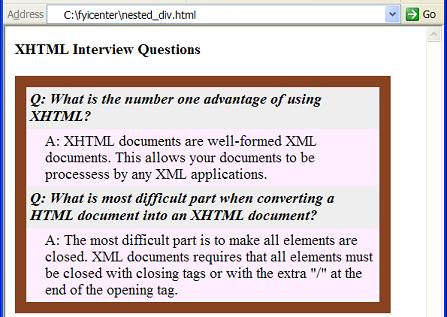|
Home >> FAQs/Tutorials >> XHTML Tutorials and Tips >> Index
XHTML Tutorial - Nested "div" Elements
(Continued from previous topic...)
Can "div" Elements Be Nested?
Can "div" elements be nested? The answer is yes. In fact,
nested "div" elements provides you more flexibilities to specify
CSS properties at different levels. Here is a tutorial example
of nested "div" elements:
<?xml version="1.0" ?>
<!DOCTYPE html PUBLIC "-//W3C//DTD XHTML 1.0 Strict//EN"
"http://www.w3.org/TR/xhtml1/DTD/xhtml1-strict.dtd">
<html>
<head>
<title>Nested DIV Elements</title>
</head>
<body>
<h4>XHTML Interview Questions</h4>
<div style="background-color: #884422; width: 400px;
padding: 12px">
<div style="background-color: #eeeeee; padding: 4px;
font-style: italic; font-weight: bold">
Q: What is the number one advantage of using XHTML?
</div>
<div style="background-color: #ffeeff;
padding: 4px 4px 4px 20px;">
A: XHTML documents are well-formed XML documents.
This allows your documents to be processed by any XML
applications.</div>
<div style="background-color: #eeeeee; padding: 4px;
font-style: italic; font-weight: bold">
Q: What is most difficult part when converting
a HTML document into an XHTML document?</div>
<div style="background-color: #ffeeff;
padding: 4px 4px 4px 20px;">
A: The most difficult part is to make all elements
are closed. XML documents requires that all elements
must be closed with closing tags or with the extra "/"
at the end of the opening tag.</div>
</div>
</body>
</html>
If you save the above document as nested_div.html and view it with
Internet Explorer, you will see that the outer "div" element helped
to define a nice looking border as shown below:

(Continued on next topic...)
- What Is a "div" Tag/Element?
- How To Use "div" Elements to Change CSS Properties?
- Can "div" Elements Be Nested?
- Can "div" Elements Be Floated?
- What Is a "span" Tag/Element?
- How To Change Text Fonts for Some Parts of a Paragraph?
|